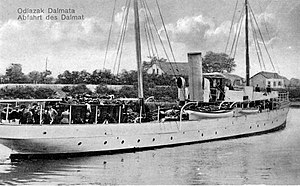 SMS Dalmat with the coffins of the victims of the Sarajevo assassination on board (1914)
| |
| History | |
|---|---|
| Name | Ossero |
| Namesake | Italian name for Osor, Croatia[1] |
| Builder | Stabilimento Tecnico Triestino in Trieste |
| Launched | 1896 |
| Out of service | 1899 |
| Fate | Transferred to Austro-Hungarian Navy |
| History | |
| Name |
|
| Namesake |
|
| Acquired | 1899 |
| Out of service | 1920 |
| Fate | Transferred to the Kingdom of Serbs, Croats and Slovenes (Yugoslavia) |
| History | |
| Name | Dalmat |
| Namesake | Alternative name for a person of the ancient Dalmatae tribe[2] |
| In service | 1920 |
| Out of service | 1941 |
| Fate | Captured by Italy |
| Name | Fata |
| Namesake | Italian for "fairy"[3] |
| Acquired | 1941 |
| Out of service | 1943 |
| Fate | Returned to Yugoslavia |
| Name | Vila |
| Namesake | Serbo-Croatian[4] and Slovene[5] for "fairy" |
| Acquired | 1943 |
| Out of service | 1945 |
| Fate | Transferred to Yugoslav Navy post-war |
| Name |
|
| Namesake | |
| Acquired | 1945 |
| Decommissioned | 1970 |
| Fate | In private ownership at Split |
| General characteristics | |
| Displacement | 260 long tons (264 t) |
| Length | 44 metres (144 ft) |
| Beam | 6.2 metres (20 ft) |
| Height | 3.5 metres (11 ft) |
| Installed power | 325 horsepower (242 kW) |
| Speed | 12 knots (22 km/h; 14 mph) |
The Dalmat was a yacht of the Austro-Hungarian Navy, Royal Yugoslav Navy, Regia Marina and the Yugoslav Navy. Built as Ossero in Trieste in 1896 she was transferred to the Austro-Hungarian Navy in 1899 and in 1901 renamed Dalmat. In 1914 she helped transport Archduke Franz Ferdinand of Austria to Sarajevo. After Ferdinand's assassination she carried his body back to Trieste. Dalmat was transferred to the Royal Yugoslav Navy in 1920 following the Dissolution of Austria-Hungary. She was captured by the Axis in 1941 and served the Italians as Fata. The vessel reverted to the Yugoslav Navy in 1943 following the Armistice of Cassibile and was renamed Vila. She remained in service under the communist government of the Socialist Federal Republic of Yugoslavia, being renamed Orjen in 1945 and Istranka in 1954. Sometime after 1972 she was decommissioned and became a floating restaurant. She was put up for sale in 1998 but lay derelict in a Croatian shipyard until purchased and restored by Italian politician Gianfranco Cozzi. Cozzi was denied permission to sail the vessel from Croatia in 2003. The vessel remains in Split harbour where it has twice sunk due to lack of maintenance.
- ^ Baldwin, Marshall W. (11 November 2016). A History of the Crusades, Volume 1: The First Hundred Years. University of Pennsylvania Press. p. 639. ISBN 978-1-5128-1864-2.
- ^ a b Shores, Louis (1964). Collier's Encyclopedia: With Bibliography and Index. Crowell-Collier Publishing Company. p. 663.
- ^ "English translation of 'fata'". Collins Italian-English Dictionary.
- ^ Delahunty, Andrew (23 October 2008). From Bonbon to Cha-cha: Oxford Dictionary of Foreign Words and Phrases. OUP Oxford. p. 374. ISBN 978-0-19-954369-4.
- ^ Kropej, Monika (1 January 2012). Supernatural beings from Slovenian myth and folktales. Založba ZRC. p. 223. ISBN 978-961-254-428-7.
- ^ Stopar, Ivan; Kordeš, Leopold (1993). Goldenstein's national costumes of Carniola (in Slovenian). Arterika. p. 10.